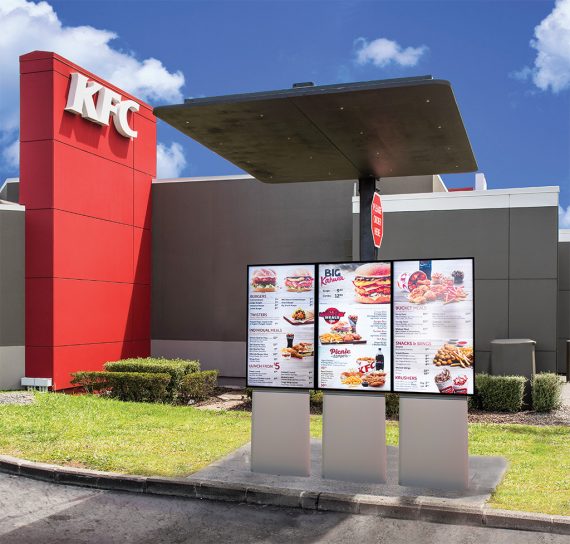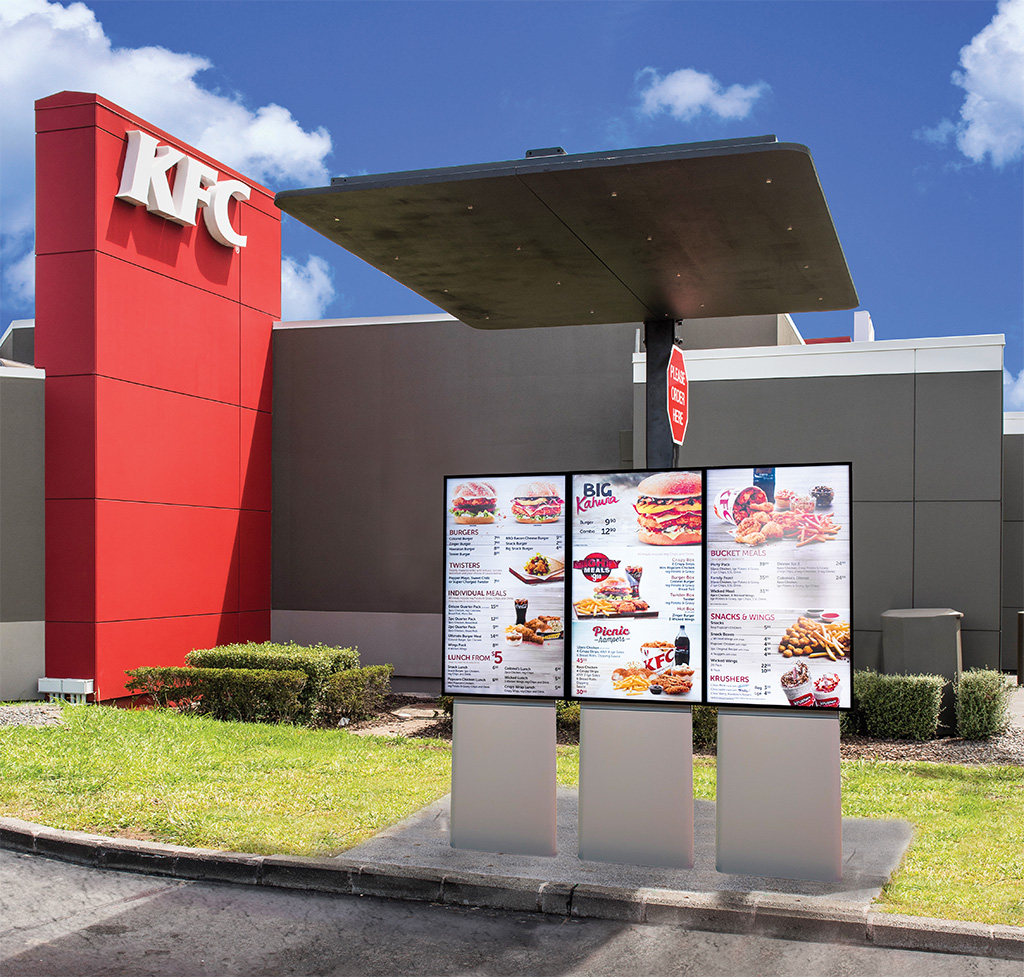
Fingermark’s Digital Cell sticks it to the harsh outdoors.
Interview: Christopher Holder
Fingermark, headquartered in New Zealand, is one of the world’s true digital signage pioneers and remains an big international player in the signage market.
DigitalSignage checked in with Fingermark’s CEO and founder Luke Irving upon the occasion of the launch of its latest generation Digital Cell outdoor screen.
CLARITY FIRST
DigitalSignage: What’s the Digital Cell’s key selling point?
Luke Irving: We’ve focused on clarity and not brightness. Others in our market are pushing 3000 nits through the glass, which uses a lot of power and creates a lot of heat you have to deal with. Digi Cell operates at a maximum of 1500 nits.
DigitalSignage: So how do you get better clarity?
Luke Irving: We bond the glass to the screen which not only helps with rigidity but reduces reflections and glare. Using this process also has great cooling properties. The heat effectively bounces off the screen, it doesn’t get caught in the air gap between screen and the glass.
It means that in markets where you can experience ambient temperatures of 50°C, the screen’s temperature is not much more than the ambient temperature. Because the chassis is extruded from one component, the transfer of heat is seamless and efficient.
The result is a stripped down, highly reliable screen. There are no moving parts to worry about — they’ve all been removed. Digi Cell is a like an unbreakable Toyota from the 80s. More cost effective than the flashier competitor and more reliable.
In the outdoors you just want things to run and run. That’s why serviceability needs to be simple and cheap.
DigitalSignage: Power consumption over a big roll out is a big issue.
Luke Irving: And we’re running at about 40% of the competitive product. We did our calculations and that represent around A$220 savings per screen on an average 16 hour day. Extrapolate that across 2000 screens and you can begin to see how much you can save across a large network.
FINGER LICKING TOUCH
DigitalSignage: Some will have heard about Fingermark’s work with KFC. Where are you at with that job?
Luke Irving: We’re just coming to the end of rolling out KFC’s digital menuboards — 600+ screens across Australia. Next year we’re working with KFC on what an outdoor screen rollout might look like. There’s a pilot trial to come.
DigitalSignage: What panel did you use for the KFC rollout?
Luke Irving: We selected Philips commercial displays for a couple of reasons: because of the Australian distributor, Westan, and because of the image quality.
Fingermark is a family-owned business and I liked the fact that Westan is a family owned business. We went through a procurement process with Yum [owners of KFC in Australia] as its tech partner. We looked at all the big brands, and we were impressed with how motivated Westan was to do business and win the contract — we realised we could work with these guys. This rollout took around two and a half years with most of the action happening in the final 12 months. Westan was willing to hold stock and ride the ups and downs of an unpredictable rollout — they always had stock when we needed it.
It just so happened that the Philips product had the nicest image during our tests — we got the Yum CEO over the line with the image. He wasn’t liking the colour hues of the competitors but he really liked the Philips image. At a really nice price point.
OUTDOOR SIGNAGE SOLUTION
The slimline panel is light weight and built to withstand harsh weather conditions from -20C to 60C.
EASY INSTALLATION
The Digital Cell units are designed for quick installation with multiple mounting options and self-sufficient setup. All that’s required is a stable surface and power lead for connection. This saves time and money.
VANDAL RESISTANT GLASS
From drive-thrus, to bus shelters, subway stations to convenience stores, the Cells are ‘All-Black’ rugged and made to last with features such as vandalproof glass and anti-graffiti powder coating.
COST EFFECTIVE
Due to Fingermark’s proprietary passive technology, it uses up to 50 percent less power than competing models. Digital Cell run on around 80c a day, with new developments set to cut costs even further.
VIVID OPTICAL EXPERIENCE
Fingermark believes clarity is the key to an optimal viewer experience. The Digital Cell displays go through an optical bonding process that reaches far beyond the function of the screen to enhance clarity, reduce solar effects and minimise glare. They are fitted with an auto dimming system which adjusts, according to brightness levels, for greater visibility.
DRIVE THRU
DigitalSignage: You mentioned a future outdoor rollout. Are touchscreens a big deal in the world of QSR drive thru?
Luke Irving: Drive thru touch is more accepted overseas but I can assure you it’s coming to Australia — I can’t reveal the details yet but there’s a drive thru-only rollout of touchscreens confirmed in Australia in the near future.
But digital in drive thru is more than the convenience of self service. We’ve been working on a smart camera-based system that changes screen content according to what type of car you drive. It’s called Stop Watch, it’s been in 18 months of development and is now ready to roll. In fact, we’ve recently signed up one of the largest QSR players in the US to the system. It’ll be fascinating to see its impact.
DigitalSignage: So if I’m driving a Fezza, does a waitress on roller skates come out to greet me, while the Datsun 180B gets a ‘keep moving fella’ warning on the screen?
Luke Irving: Not exactly. The camera recognises the car and will display an appropriate image based on what that car would most likely order. It can machine learn through the back end as well, so it will slowly become more accurate over time. We’ll keep the options tight initially, say, six offerings, based on the car, whether that be a ute, a van, a people mover etc.
DigitalSignage: Anything else in the pipeline for KFC?
Luke Irving: We’ll be launching a KFC self-ordering kiosk in New Zealand. That’s something that will inevitably be rolled out in Australia.
The KFC approach is more like a thoroughbred ‘queue buster’ than McDonald’s Create Your Taste kiosks. We believe the prime purpose of a QSR kiosk is for a quick turnaround. We don’t believe the McDonald’s solution is the right way to go. Others love it, but I believe it gives people too many options. Certainly confuses me!

URBAN UPTAKE
DigitalSignage: What next for outdoor touch, and the Digital Cell?
Luke Irving:Outdoor touchscreens are going to become a big part of any future ‘smart city’ initiative. We’re working on a big project in New Zealand like this.
New York City’s Link project is big and successful. It’s also very expensive but I believe it will pay dividends when other cities jump on board.
I think e-paper will become prevalent in the next few years as well. After they get full colour on e-ink that will start taking over in the transport space. The price point has to come down but the benefits of running off 6 or 7 Watts of solar power is compelling. There are lots of good e-paper opportunities and it’s another example of a technology that needs a large rollout to keep the overall costs down.
Fingermark: www.fingermarkglobal.com


